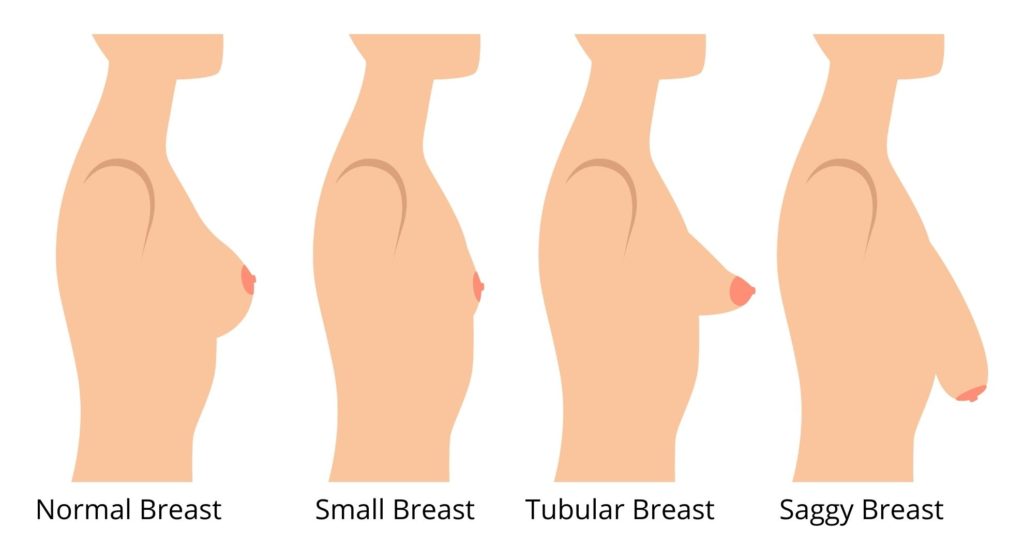What are the symptoms of tubular breasts?
Tubular breasts, also known as tuberous breasts, are a condition where the breast tissue develops in a tube-like or elongated shape rather than a more rounded form. The symptoms of tubular breasts can vary but commonly include:
- Uneven Shape: The breasts may appear asymmetrical or uneven in shape, with one breast possibly appearing more tubular or elongated than the other.
- Narrow Base: The base of the breast may be narrow, with a more prominent or protruding areola.
- High Nipple Position: The nipples may be positioned higher on the breast compared to typical breast anatomy.
- Lack of Fullness: There may be a lack of fullness or volume in the lower part of the breast, giving a more flattened appearance.
- Areolar Enlargement: The areolas might be larger than usual and can sometimes be more prominent or protruding.
- Increased Spacing: There may be increased spacing between the breasts, which can affect the overall symmetry.
These symptoms can vary in severity, and some individuals may experience a combination of these features. Tubular breasts are a congenital condition, meaning they are present from birth, and they can affect a person’s self-esteem and body image. If you have concerns about breast shape or appearance, consulting with a healthcare provider or a plastic surgeon can help determine the appropriate course of action, which might include cosmetic surgery to address these concerns.
What are the causes of tubular breasts?
Tubular breasts, or tuberous breasts, result from a developmental abnormality in the breast tissue. The exact cause is not always clear, but several factors may contribute to the condition:
- Genetic Factors: There may be a genetic component, as tubular breasts can sometimes run in families. Genetic predispositions can affect breast development.
- Hormonal Imbalances: Imbalances in hormones, particularly during puberty, may influence breast tissue development. Abnormal levels of estrogen and progesterone can affect how the breast tissue forms.
- Developmental Issues: Tubular breasts arise from abnormal development of the breast tissue during puberty. The condition is thought to occur due to the underdevelopment of the breast tissue and an uneven growth pattern.
- Structural Abnormalities: Abnormalities in the connective tissue or the ligaments that support the breast can lead to the tubular appearance. The breast tissue may fail to expand normally, resulting in a more elongated shape.
- Poor Blood Supply: In some cases, inadequate blood flow to the breast tissue during development might contribute to the formation of tubular breasts.
Although these factors can contribute to the development of tubular breasts, the condition is usually congenital, meaning it is present from birth and becomes more noticeable during puberty as the breasts develop. If you have concerns about tubular breasts or related symptoms, consulting a healthcare provider or a specialist in breast health can offer more personalized insights and management options.
What is the treatment for tubular breasts?
Treatment for tubular breasts typically focuses on improving breast shape and symmetry. One common approach is surgical intervention, which can include breast augmentation to enhance volume and shape using implants. A breast lift may also be performed to reposition the breasts and nipples and to address any enlarged areolas. Sometimes, a combination of augmentation and lift is needed to achieve the desired result.
For those who prefer non-surgical options, padding and shaping garments, such as special bras or padded inserts, can help create a more balanced appearance temporarily. Additionally, body contouring techniques like fat grafting or liposuction might be used in conjunction with other treatments to enhance breast shape.
Counseling and support may also be beneficial for individuals concerned about the impact of tubular breasts on their self-esteem or body image. Psychological counseling or support groups can help address emotional well-being.
Consulting with a plastic surgeon or a specialist in breast reconstruction is crucial to determine the most appropriate treatment based on the specific characteristics of the tubular breasts and the individual’s goals.

Leave a Reply
You must be logged in to post a comment.